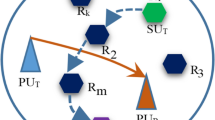Abstract
Designing an efficient routing protocol for cognitive radio networks is critical due to the dynamic behavior of the primary users. Based on empirical studies, the primary users activity on the licensed channels has periodicity comprised of several stages, and that the model of primary users activity may change during different stages. This paper has identified two main challenges facing designers: how to transmit packets via a stable route, and how to ensure imposing of minimal interference on the primary users. To address these, we propose a routing protocol which is based on a generalized version of Q-learning and which exploits the said model of primary users behavior. We divide the infinite time horizon into cycles (corresponding to periods), then break each cycle into several sub-cycles (corresponding to stages), making an assumption that the statistical model parameters of the primary users activity will not change during a sub-cycle. The extensive simulations confirm that our proposed routing approach outperforms existing schemes in terms of throughput and minimal interference. The paper also verifies that imposing of significant interference on the primary users and degradation of QoS of secondary users stem from lack of attention to the multi-stage periodic behavior of primary users.









Similar content being viewed by others
References
FCC, E. (2003). Docket no 03-222 notice of proposed rule making and order.
Mitola, J. (2000). Cognitive radio—An integrated agent architecture for software defined radio.
Haykin, S. (2005). Cognitive radio: Brain-empowered wireless communications. IEEE Journal on Selected Areas in Communications, 23(2), 201–220.
Akyildiz, I. F., Lee, W. Y., & Chowdhury, K. R. (2009). Crahns: Cognitive radio ad hoc networks. AD Hoc Networks, 7(5), 810–836.
Al-Rawi, H., & Yau, A. (2013). Routing in distributed cognitive radio networks: A survey. Wireless Personal Communications, 69(4), 1983–2020.
Caleffi, M., & Cacciapuoti, A. S. (2016). Optimal database access for tv white space. IEEE Transactions on Communications, 64(1), 83–93.
Cacciapuoti, A. S., Caleffi, M., & Paura, L. (2016). Optimal strategy design for enabling the coexistence of heterogeneous networks in tv white space. IEEE Transactions on Vehicular Technology, 65(9), 7361–7373.
Wellens, M., RiihijäRvi, J., & MäHöNen, P. (2009). Empirical time and frequency domain models of spectrum use. Physical Communication, 2(1), 10–32.
Macone, D., Oddi, G., & Pietrabissa, A. (2013). Mq-routing: Mobility-, gps-and energy-aware routing protocol in manets for disaster relief scenarios. Ad Hoc Networks, 11(3), 861–878.
Shiang, H. P., & Van der Schaar, M. (2009). Distributed resource management in multihop cognitive radio networks for delay-sensitive transmission. IEEE Transactions on Vehicular Technology, 58(2), 941–953.
Xia, B., Wahab, M. H., Yang, Y., Fan, Z., & Sooriyabandara, M. (2009). Reinforcement learning based spectrum-aware routing in multi-hop cognitive radio networks. In 2009. CROWNCOM’09. 4th international conference on cognitive radio oriented wireless networks and communications (pp. 1–5). IEEE.
Zheng, K., Li, H., Qiu, R. C., & Gong, S. (2012). Multi-objective reinforcement learning based routing in cognitive radio networks: Walking in a random maze. In 2012 international conference on computing, networking and communications (ICNC) (pp. 359–363). IEEE.
Al-Rawi, H., Yau, A., Mohamad, H., Ramli, N., & Hashim W., et al. (2014). A reinforcement learning-based routing scheme for cognitive radio ad hoc networks. In 2014 7th IFIP wireless and mobile networking conference (WMNC) (pp. 1–8). IEEE.
Wang, W., Kwasinski, A., & Han, Z. (2014). Routing based on layered stochastic games for multi-hop cognitive radio networks. In 2014 IEEE wireless communications and networking conference (WCNC) (pp. 63–68). IEEE.
Saleem, Y., Yau, A., Mohamad, H., Ramli, N., & Rehmani, M. H. (2015). Smart: A spectrum-aware cluster-based routing scheme for distributed cognitive radio networks. Computer Networks, 91, 196–224.
Geirhofer, S., Tong, L., & Sadler, B. M. (2008). Cognitive medium access: Constraining interference based on experimental models. IEEE Journal on Selected Areas in Communications, 26(1), 95–105.
Sutton, R. S., & Barto, A. G. (1998). Reinforcement learning: An introduction (Vol. 1). Cambridge: MIT Press.
Xing, X., Jing, T., Huo, Y., Li, H., & Cheng, X. (2013). Channel quality prediction based on Bayesian inference in cognitive radio networks. In INFOCOM, 2013 proceedings IEEE (pp. 1465–1473). IEEE.
Varga, A. (2010). Omnet++ user manual.
Bayhan, S., & Alagöz, F. (2012). Distributed channel selection in crahns: A non-selfish scheme for mitigating spectrum fragmentation. Ad Hoc Networks, 10(5), 774–788.
Author information
Authors and Affiliations
Corresponding author
Rights and permissions
About this article
Cite this article
Soheil Shamaee, M., Shiri, M.E. & Sabaei, M. A Reinforcement Learning Based Routing in Cognitive Radio Networks for Primary Users with Multi-stage Periodicity. Wireless Pers Commun 101, 465–490 (2018). https://doi.org/10.1007/s11277-018-5700-y
Published:
Issue Date:
DOI: https://doi.org/10.1007/s11277-018-5700-y




